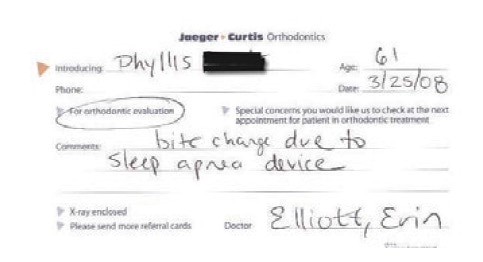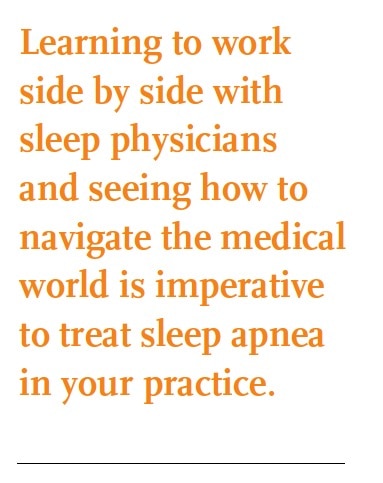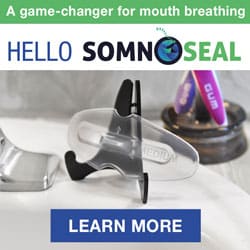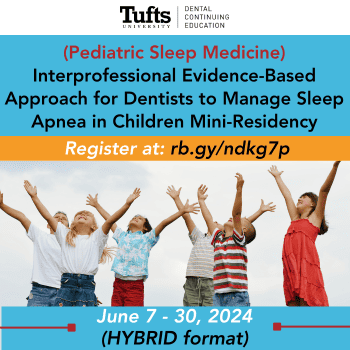by Dr. Erin E. Elliott
 You are reading this magazine because there’s always more to learn about treating sleep apnea – I’ll get to that. But first, let me start out by telling you why I NEVER wanted to make sleep appliances in my practice. In 2008, 5 years out of dental school, one thing I was absolutely sure of was that if a patient had Class I canine guidance then all was right in the world. One of my favorite patients, Phyllis B., had that perfect bite until she came in with (cue scary music) a posterior open bite! Gasp! The horror! I furiously wrote a referral to the orthodontist to get this immediately fixed. How dare a dentist make MY patient an oral appliance to help her airway at night that could potentially change her bite. You can even tell how mad I was by my messy handwriting. Oh wait… my handwriting is always messy. In all of his wisdom, the orthodontist sent me the consult notes that stated “No orthodontic treatment recommended at this time.” Do you know why? Because she was breathing at night, because she was getting oxygen, and because she wasn’t slowly dying in her sleep. Do you know the best part? The patient didn’t even know she had a bite change. She didn’t even care.
You are reading this magazine because there’s always more to learn about treating sleep apnea – I’ll get to that. But first, let me start out by telling you why I NEVER wanted to make sleep appliances in my practice. In 2008, 5 years out of dental school, one thing I was absolutely sure of was that if a patient had Class I canine guidance then all was right in the world. One of my favorite patients, Phyllis B., had that perfect bite until she came in with (cue scary music) a posterior open bite! Gasp! The horror! I furiously wrote a referral to the orthodontist to get this immediately fixed. How dare a dentist make MY patient an oral appliance to help her airway at night that could potentially change her bite. You can even tell how mad I was by my messy handwriting. Oh wait… my handwriting is always messy. In all of his wisdom, the orthodontist sent me the consult notes that stated “No orthodontic treatment recommended at this time.” Do you know why? Because she was breathing at night, because she was getting oxygen, and because she wasn’t slowly dying in her sleep. Do you know the best part? The patient didn’t even know she had a bite change. She didn’t even care.

Whoa! This is a life changing and career changing paradigm shift in my indoctrination. Some of my favorite quotes from the leaders in Dental Sleep Medicine include: “Open casket? Or open bite?” and “Teeth shift, get over it.” I say, “Oxygen trumps bite every time.” When I realized that not only could I help my patients smile confidently by providing life changing dentistry but that I could also help save their life by providing an oral appliance, I immediately pursued learning more about Dental Sleep Medicine. Besides I don’t know anyone who loves to sleep more than me.
 I started out simply. The Idaho State Dental Convention convened in Boise that year and had a sleep physician speak in the morning and a sleep dentist speak in the afternoon. It was enough to get me interested. But most importantly it was enough for me to realize that Dental Sleep Medicine is more than taking 2 impressions and making a piece of plastic. It’s dangerous to treat people without a sleep study and proper follow-up. Besides, if I just started providing appliances which one would I choose? And what happens if I get a side effect or the appliance wasn’t effective enough? Like any good youth of today, I went to the internet and found an introduction course in Dallas, Texas. Dallas was a cool place to visit right? I knew nothing about Kent Smith at that time but have found him to be one of the wisest mentors around. That was 2009; in 2015 there are many, many intro courses to choose from. Even courses by Moi. How can you choose? Some of the questions I would ask are: Who is sponsoring it? What is the curriculum? Who is teaching it? How much is it? Do I need to buy “stuff” before I make my tuition back? Do they teach medical insurance billing? How much time/CE credits do they offer?
I started out simply. The Idaho State Dental Convention convened in Boise that year and had a sleep physician speak in the morning and a sleep dentist speak in the afternoon. It was enough to get me interested. But most importantly it was enough for me to realize that Dental Sleep Medicine is more than taking 2 impressions and making a piece of plastic. It’s dangerous to treat people without a sleep study and proper follow-up. Besides, if I just started providing appliances which one would I choose? And what happens if I get a side effect or the appliance wasn’t effective enough? Like any good youth of today, I went to the internet and found an introduction course in Dallas, Texas. Dallas was a cool place to visit right? I knew nothing about Kent Smith at that time but have found him to be one of the wisest mentors around. That was 2009; in 2015 there are many, many intro courses to choose from. Even courses by Moi. How can you choose? Some of the questions I would ask are: Who is sponsoring it? What is the curriculum? Who is teaching it? How much is it? Do I need to buy “stuff” before I make my tuition back? Do they teach medical insurance billing? How much time/CE credits do they offer?
Is two days really enough? Yes and no. It is enough to learn the basics of sleep medicine, the medical part. It is enough to learn dental signs and symptoms. It is enough to learn which appliance to use in which situation. Should you use just one appliance? No! So make sure you learn from a course that teaches more than just the appliance that is sponsoring the course. And 2 days is enough to learn the basics of medical billing. But 2 days is not enough to learn about the changing landscape of DSM and the in-depth medical side. There are 3 and 4 day intro courses as well provided by such groups as Pankey, Dawson and Spear, the leaders in teaching the occlusion that was my comfort zone. LVI has a great series on DSM as they believe that airway is king when treating restorative cases.
What I did after my first 2 day course was come back to the office, try to share the excitement with my team, and start treating family and friends. I found the most important lesson during that time was learning what I didn’t know and pursuing more education.
There are mini-residencies available at both Tufts and UCLA. The American Academy of Dental Sleep Medicine has a three-day conference every year tied in with the medical branch of the American Academy of Sleep Medicine. They also have courses available throughout the year. The American Sleep and Breathing Academy – Dental Division has an annual conference in Scottsdale that is multi-disciplinary. I think these conferences are a great way to learn from the medical side and learn the dental side in a very unbiased fashion. Learning to work side by side with sleep physicians and seeing how to navigate the medical world is imperative to treating sleep apnea in your practice. I like to say, “It is time to put the handpiece down and put the stethoscope on.” We, as dentists, are providing a dental solution to a medical problem. There is no class available teaching you how to interact with your medical community but it can begin as a simple lunch-n-learn or an observation at a sleep lab. My entire goal is to figure out the best referral pathway for my patient. If I have a patient with signs and symptoms of sleep apnea I don’t want an uphill climb to consult, test, diagnosis, treat, and confirm effectiveness. What is the best way for my typical patient to get help? To find out, I hit the pavement. I talked to any MD and sleep physician I could, to let them know the facts and the motivation behind my ‘madness.’
There are various other academies that have advanced learning tracks in treating pain and TMJ patients such as the AACP (American Academy of Craniofacial Pain) and the American Academy of Orofacial Pain. Great teachers like Drs. Jeffery Rouse, Steven Olmos and Dr. William Hang, who is an orthodontist, also have courses for basic and advanced learning.
I get notifications everyday for webinars and I am more than happy to NOT mark them as SPAM. These have been great learning tools for me to learn from very wise dentists and MD’s in the comfort of my home; Post Falls, Idaho, isn’t, shall we say, a metropolis that these speakers come to very often.
 I also read everything I can get my hands on. There are two main books that cover DSM that I ordered through Amazon (that’s the only way I shop for anything anymore): Sleep Medicine for Dentists: A Practical Overview by Giles Lavigne and Dental Management of Sleep Disorders by Dr. Dennis Bailey and Dr. Ronald Attasino. This may reveal my nerdy side but I also got my hands on a medical school Sleep Medicine textbook. The exciting part in the dental world is how many articles are coming out in our professional journals and magazines; the launch of Dental Sleep Practice last year is case in point! The more that dentists know how to screen patients and get them to proper diagnosis, not be content to stop with snore guards, the more our world will be a better place.
I also read everything I can get my hands on. There are two main books that cover DSM that I ordered through Amazon (that’s the only way I shop for anything anymore): Sleep Medicine for Dentists: A Practical Overview by Giles Lavigne and Dental Management of Sleep Disorders by Dr. Dennis Bailey and Dr. Ronald Attasino. This may reveal my nerdy side but I also got my hands on a medical school Sleep Medicine textbook. The exciting part in the dental world is how many articles are coming out in our professional journals and magazines; the launch of Dental Sleep Practice last year is case in point! The more that dentists know how to screen patients and get them to proper diagnosis, not be content to stop with snore guards, the more our world will be a better place.
I am a member of several forums. The Wasted Day and Sleepless Nights, Dental Nexus and Sleep Better Northwest forums have made me a better sleep apnea dentist. This is where I think the real-world, case by case learning occurs. I feel blessed to be a part of a community that provides a continuous opportunity to learn and to be better clinicians and to navigate the ever-changing landscape of DSM.
The most difficult part of learning anything is incorporating it into the practice. All the head knowledge in the world will not help you if you aren’t treating cases. The best advice I can give you is to implement systems and protocols into your practice by training every single member of your team. I’ve made many mistakes over the 6 years I’ve been doing this and mistake #1 was not having everybody from front to back helping in the screening, treating and billing. The chain is only as strong as its weakest link. There are sleep dentists and other types of trainers who will come to your office to train your team. One resource I’ve just learned about is OSA University – they have online training for teams, so you don’t even have to go on an expensive trip to get your people up to speed.
Let me leave you with this… get trained and get trained now. Continue to learn so that you can have an impact not only with your patients but your team and your community. We are saving lives! When you actually put the training to use each and every day is when you have the most impact. At a recent course I taught, I had each of the 30 team members focus their energy to put out a candle lit in the middle of the circle. We sat there uncomfortably, waiting for their positive thoughts to do something, for a full minute before I finally got up and blew the candle out. The moral of the story? All of the education and positive thoughts in the world will do NOTHING if you don’t get off of your derrière and take action!






